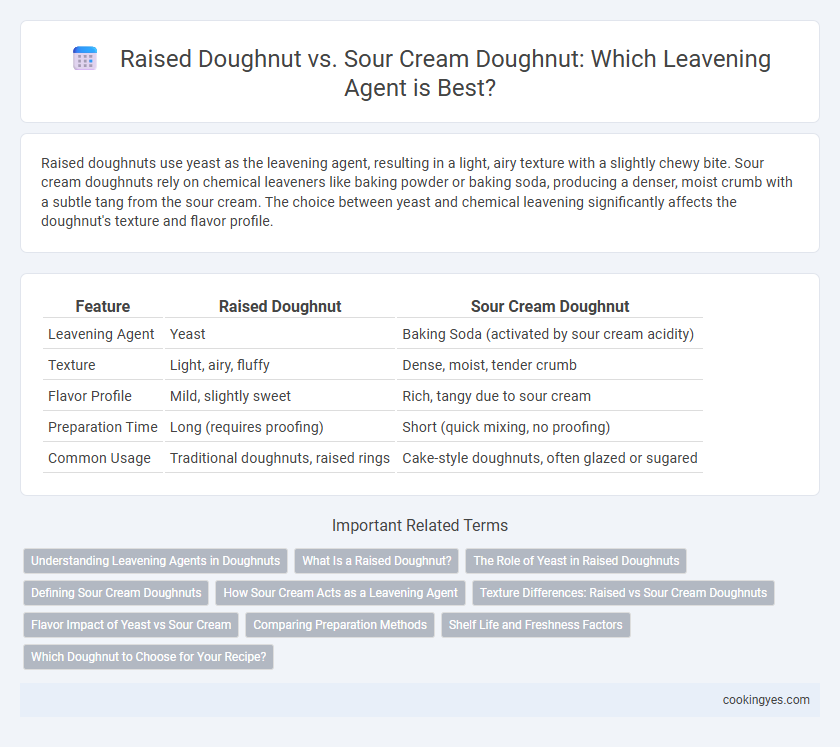Raised doughnuts use yeast as the leavening agent, resulting in a light, airy texture with a slightly chewy bite. Sour cream doughnuts rely on chemical leaveners like baking powder or baking soda, producing a denser, moist crumb with a subtle tang from the sour cream. The choice between yeast and chemical leavening significantly affects the doughnut's texture and flavor profile.
Table of Comparison
| Feature | Raised Doughnut | Sour Cream Doughnut |
|---|---|---|
| Leavening Agent | Yeast | Baking Soda (activated by sour cream acidity) |
| Texture | Light, airy, fluffy | Dense, moist, tender crumb |
| Flavor Profile | Mild, slightly sweet | Rich, tangy due to sour cream |
| Preparation Time | Long (requires proofing) | Short (quick mixing, no proofing) |
| Common Usage | Traditional doughnuts, raised rings | Cake-style doughnuts, often glazed or sugared |
Understanding Leavening Agents in Doughnuts
Raised doughnuts use yeast as the leavening agent, which ferments the dough and produces carbon dioxide, resulting in a light, airy texture with a slightly chewy crumb. Sour cream doughnuts rely on chemical leaveners like baking powder or baking soda, which react quickly with acidic components to create carbon dioxide, yielding a tender, moist, and denser crumb. Understanding these leavening differences is crucial for achieving the desired texture and flavor profile in doughnut recipes.
What Is a Raised Doughnut?
A raised doughnut uses yeast as its leavening agent, creating a light and airy texture through fermentation and gas production. In contrast, a sour cream doughnut relies on baking powder or baking soda combined with sour cream, resulting in a denser, tender crumb. The yeast in raised doughnuts produces a distinct flavor and a fluffy interior, which distinguishes it from chemically leavened sour cream varieties.
The Role of Yeast in Raised Doughnuts
Raised doughnuts rely on yeast as a natural leavening agent, which ferments the dough and produces carbon dioxide, creating a light and airy texture. In contrast, sour cream doughnuts use chemical leavening agents like baking powder, resulting in a denser and more cake-like consistency. Yeast fermentation in raised doughnuts also contributes to a distinct flavor profile that sets them apart from sour cream varieties.
Defining Sour Cream Doughnuts
Sour cream doughnuts use baking soda as the primary leavening agent, reacting with the acidity in sour cream to create a tender, moist crumb distinct from raised doughnuts that rely on yeast fermentation for lightness and rise. Unlike raised doughnuts, which undergo an hour or more of proofing, sour cream doughnuts achieve a quicker preparation time due to immediate chemical leavening. The incorporation of sour cream not only activates the baking soda but also imparts subtle tanginess, enhancing the overall flavor and texture profile compared to yeast-leavened varieties.
How Sour Cream Acts as a Leavening Agent
Sour cream acts as a leavening agent in doughnuts by providing acidity that reacts with baking soda, producing carbon dioxide bubbles that help the dough rise and create a tender crumb. Unlike raised doughnuts, which rely on yeast fermentation for leavening, sour cream doughnuts achieve lift chemically, resulting in a denser, moister texture. This acid-base reaction enhances the dough's softness and shelf life while delivering a distinctive tangy flavor profile.
Texture Differences: Raised vs Sour Cream Doughnuts
Raised doughnuts use yeast as the leavening agent, resulting in a light, airy texture with a soft and fluffy crumb due to fermentation creating gas bubbles. Sour cream doughnuts rely on chemical leavening agents like baking powder or baking soda combined with the acidity of sour cream, producing a denser, tender crumb with a moist, cake-like texture. The fermentation in raised doughnuts creates a more open structure, while sour cream doughnuts have a tighter, finer crumb and richer mouthfeel.
Flavor Impact of Yeast vs Sour Cream
Raised doughnuts use yeast as the leavening agent, which imparts a light, airy texture and a subtle, slightly tangy flavor developed through fermentation. Sour cream doughnuts rely on sour cream and baking powder or soda for leavening, resulting in a denser crumb with a rich, tangy taste from the dairy's acidity. The yeast in raised doughnuts contributes complex flavor notes and a chewy texture, while sour cream enhances moisture and adds a distinct creamy tang.
Comparing Preparation Methods
Raised doughnuts utilize yeast as the leavening agent, which requires a longer fermentation period allowing the dough to rise and develop a light, airy texture. Sour cream doughnuts rely on baking powder or baking soda combined with the acidity of sour cream for chemical leavening, resulting in a denser, moist crumb and quicker preparation time. The yeast fermentation in raised doughnuts enhances flavor complexity, while the chemical leavening in sour cream doughnuts offers convenience and tenderness.
Shelf Life and Freshness Factors
Raised doughnuts use yeast as the leavening agent, which helps create a light, airy texture but tends to reduce shelf life due to moisture retention, leading to quicker staling. Sour cream doughnuts rely on chemical leaveners like baking powder combined with sour cream, which contributes to a denser crumb and extends freshness by slowing down moisture loss. When considering shelf life, sour cream doughnuts generally stay fresher longer than raised doughnuts, making them a preferred choice for extended storage.
Which Doughnut to Choose for Your Recipe?
Raised doughnuts use yeast as a leavening agent, producing a light, airy texture ideal for those seeking a fluffy treat. Sour cream doughnuts rely on baking powder and the acidity of sour cream for leavening, resulting in a denser, moist crumb with a rich flavor. Choose raised doughnuts for a classic airy bite or sour cream doughnuts for a tender, cake-like consistency in your recipe.
Raised doughnut vs Sour cream doughnut for leavening agent Infographic

 cookingyes.com
cookingyes.com